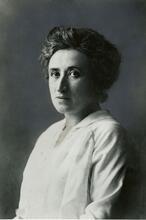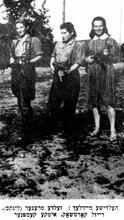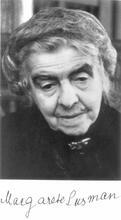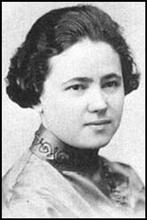Angelica Balabanoff
Angelica Balabanoff with David Ben Gurion in Tel Aviv, 1962.
Image courtesy of the Israel National Photo Collection (D684-054).
Angelica Balabanoff was one of the best-known and widely beloved figures of European socialism of her day. During her studies, she befriended many major figures of the socialist Second International, especially members of the Italian socialist movement. After completing her doctorate, she traveled to Switzerland and Italy, where she held leadership positions in socialist parties. An outspoken opponent of authoritarianism and corruption in all forms, she served a brief stint as secretary of the Communist International in the Soviet Union but was removed for protesting Lenin’s rule. She left Europe during World War II and moved to New York, where she wrote several memoirs and a biography of Italian fascist dictator Benito Mussolini. After the war, she returned to Italy to aid the Socialist Party.
Angelica Balabanoff was one of the best-known and widely beloved figures of European socialism in the early decades of the twentieth century. She left home in the Ukraine at age nineteen to study in Belgium, and began a lifetime of travel and activism that was to center around the politics of the Second International and bring her into contact with a fascinating range of political figures, including Rosa Luxemburg, Clara Zetkin, Leon Trotsky, V. I. Lenin, Emma Goldman, Alexander Berkman, and Benito Mussolini. During and after World War I, she was a major figure of the left wing of the Socialist movement and a member of the Zimmerwald Group. She returned to Russia after the Revolution of 1917 and served as an officer of the Comintern before becoming disillusioned by the authoritarianism and corruption of the Bolshevik regime.
Early Life and Education
Born in Chernigov, near Kiev, in the Ukraine, in 1878, the youngest of sixteen children, seven of whom had died before she was born, Angelica was raised to be the “crown of the family.” Her family was quite wealthy—her father was a landowner and businessman—and she was educated at home by a series of governesses and tutors. From early youth, Balabanoff was troubled by the privileges she and her family enjoyed, reporting in her autobiography that she “cringed with shame” at the way the servants regularly humiliated themselves before her and her parents. She attributed her own rebelliousness and commitment to the cause of social justice not to any influence of her Jewish heritage (about which she makes no mention in her autobiography), but to these experiences at home, and her sense of an “unbridgeable abyss” between herself and her “despotic” mother.
She left home in 1897 to study at the Université Nouvelle in Brussels, an institution known for its radicalism. There, she hoped to learn how to translate her passion for social justice into more practical strategies for aiding the downtrodden. Through the combination of classes at the university and meetings at the socialist-sponsored People’s House, she met and was deeply influenced by George Plekhanoff and a variety of other Russian and Italian emigrés, who befriended her and introduced her to many of the major figures of the Second International. After doing research in the library of the British Museum, she returned to Brussels, receiving a doctorate in philosophy and literature from the Université Nouvelle. She then went to Leipzig, and on to Rome, where she studied with the Italian Marxist philosopher Antonio Labriola and began what was to be a lifelong relationship with the Italian (and, ultimately, international) socialist movement.
Organizing and Representing the Italian Socialist Movement
From 1901 to 1902, Balabanoff worked with Italian immigrant workers in Switzerland, and organized among young women who had been recruited by the Swiss to be a docile labor force. Although she was hostile to feminism, which she viewed as bourgeois, she was deeply committed to addressing the needs of working-class women as well as men—needs she believed would be best met through socialist transformation. She was extremely successful as both a speaker and a journalist. Elected to the executive committee of the Italian Socialist Party in Switzerland, she served as its official representative to congresses of the Second International in 1907 and 1910. Also during this period, she met and befriended a poor Italian emigré, Benito Mussolini, helping him to find work and introducing him to socialist clubs in which he, too, became active.
In 1910, she left Switzerland for Italy, where she began her active involvement in the Italian socialist movement. In the ensuing years, she was elected to the party’s Central Committee; served as coeditor of the party’s official organ, Avanti; and increasingly came to support the more revolutionary (antireformist) wing of the Italian Socialist Party. Disillusioned by the failure of socialist internationalism in 1914, she helped to found and remained active throughout the war in the Zimmerwald movement, an organization of socialists protesting imperialism and demanding immediate peace. Her fluency in many languages, combined with her strong commitment to international socialism and her popularity as a public speaker, made her an indispensable figure at socialist conferences and conventions.
Challenging Authoritarianism and Corruption
Although she rejected Lenin’s call for socialist revolutions to end the war, Balabanoff returned to Russia in 1917 to help rally international support for revolutionary Russia. Despite her reservations (which she shared with Emma Goldman and Alexander Berkman, during their exile in Russia), she became secretary of the Communist International in 1919, but was removed from that position after about a year for opposing the corrupt and manipulative tactics of Lenin and Zinoviev.
Early in 1921, she left Russia forever. In the ensuing years, she suffered from a continuing campaign of slander on the part of Lenin and his associates. After living for a while in Vienna and in Paris, she spent the years of World War II in New York City, where she became friends with Norman Thomas and was an occasional contributor to Socialist Review. Balabanoff dedicated herself to awakening the American population to the dangers of Italian fascism, publishing The Traitor: Benito Mussolini and His “Conquest” of Power, as well as her autobiography, My Life as a Rebel. At the end of the war, she returned to Italy, where she continued to be active in the Italian Socialist Party. She died in Rome on November 25, 1965.
Selected Works
My Life as a Rebel. New York, London: Harper & Bros., 1938.
The Traitor: Benito Mussolini and His “Conquest” of Power. New York: The Author, 1942–1943.
Impressions of Lenin. Translated by Isotta Cesari. Ann Arbor: University of Michigan Press, 1964.
Florence, Ronald. Marx’s Daughters: Eleanor Marx, Rosa Luxemburg, Angelica Balabanoff. New York: Dial Press, 1975.
Mullaney, Marie Marmo. Revolutionary Women: Gender and the Socialist Revolutionary Role. New York: Praeger, 1983.
Obituary. NYTimes, November 26, 1965, 37:3.
Uglow, Jennifer S. and Frances Hinton, editors. The Continuum Dictionary of Women’s Biography. New York: Continuum, 1989.
UJE.










